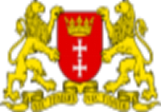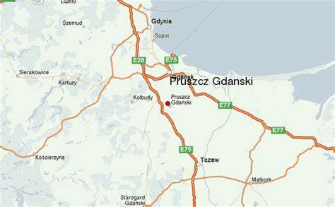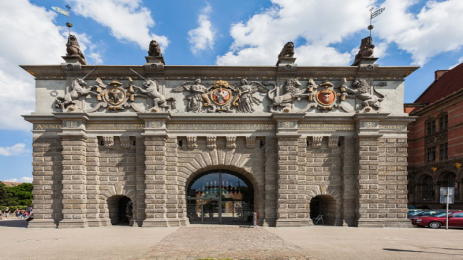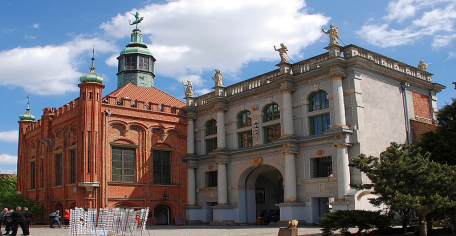Gdańsk-Pomeranian 作者: 来源: 发布时间:2021-03-09
Ⅰ. Population and Area
Population (31 December 2019)
• City 470,907 Increase (6th)
• Density 1,787/km2 (4,630/sq mi)
Area
• City 262 km2 (101 sq mi)
Website Gdańsk - the official site of the city
https://www.gdansk.pl/en/authorities

Ⅱ.Natural Geography (environment and resources)
- The city is situated on the southern edge of Gdańsk Bay on the Baltic Sea, in a conurbation with the city of Gdynia, the resort town of Sopot, and suburban communities; these form a metropolitan area called the Tricity (Trójmiasto), with a population approaching 1.4 million. Gdańsk lies at the mouth of the Motława River, connected to the Leniwka, a branch in the delta of the nearby Vistula River, which drains 60 percent of Poland and connects Gdańsk with the Polish capital, Warsaw. Together with the nearby port of Gdynia, Gdańsk is also a notable industrial centre.

- Gdańsk has a climate with both oceanic and continental influences. According to some categorizations, it has an oceanic climate (Cfb), while others classify it as belonging to the continental climate zone (Dfb). It actually depends on whether the mean reference temperature for the coldest winter month is set at −3 °C (27 °F) or 0 °C (32 °F). Gdańsk's dry winters and the precipitation maximum in summer are indicators of continentality. However seasonal extremes are less pronounced than those in inland Poland.
- Transport
- Gdańsk Lech Wałęsa Airport – an international airport located in Gdańsk;
- The Szybka Kolej Miejska, (SKM) the Fast Urban Railway, functions as a Metro system for the Tricity area including Gdańsk, Sopot and Gdynia, operating frequent trains to 27 stations covering the Tricity. The service is operated by electric multiple unit trains at a frequency of 6 minutes to 30 minutes between trains (depending on the time of day) on the central section between Gdańsk and Gdynia, and less frequently on outlying sections. The SKM system has been extended northwest of the Tricity, to Wejherowo, Lębork and Słupsk, 110 kilometres (68 miles) west of Gdynia, and to the south it has been extended to Tczew, 31 kilometres (19 miles) south of Gdańsk.
- Railways: The principal station in Gdańsk is Gdańsk Główny railway station, served by both SKM local trains and PKP long-distance trains. In addition, long-distance trains also stop at Gdańsk Oliwa railway station, Gdańsk Wrzeszcz railway station, Sopot and Gdynia. Gdańsk also has nine (9) other railway stations, served by local SKM trains;
- Long-distance trains are operated by PKP Intercity which provides connections with all major Polish cities, including Warsaw, Kraków, Łódź, Poznań, Katowice and Szczecin, and with the neighbouring Kashubian Lakes region.
- In 2011–2015 the Warsaw-Gdańsk-Gdynia railway route underwent a major upgrading costing $3 billion, partly funded by the European Investment Bank, including track replacement, realignment of curves and relocation of sections of track to allow speeds up to 200 km/h (124 mph), modernization of stations, and installation of the most modern ETCS signalling system, which was completed in June 2015. In December 2014 new Alstom Pendolino high-speed trains were put into service between Gdańsk, Warsaw and Kraków reducing the rail travel time from Gdańsk to Warsaw to 2 hours 58 minutes, further reduced in December 2015 to 2 hours 39 minutes.
- A new railway, Pomorska Kolej Metropolitalna (PKM, the 'Pomeranian Metropolitan Railway'), commenced service on 1 September 2015, connecting Gdańsk Lech Wałęsa Airport with Wrzeszcz and downtown Gdańsk. It connects to the Szybka Kolej Miejska (Tricity) (SKM) which provides further connections to the entire area served by SKM.
- City buses and trams are operated by ZTM Gdańsk (Zarząd Transportu Miejskiego w Gdańsku).
- From 1 October 2018 selected circuits of line 31 from PKT Gdynia go to bus stop Sopot Ergo Arena without trolley pole. Small part of this rote passes through Gdańsk.
- Port of Gdańsk – a seaport located on the southern coast of Gdańsk Bay within the city;
- Obwodnica Trojmiejska – part of expressway S6 that bypasses the cities of Gdańsk, Sopot and Gdynia.
- The A1 motorway connects the port and city of Gdańsk with the southern border of the country. As of 2014, some fragments of the A1 motorway are still incomplete.
- Gdańsk is the starting point of the EuroVelo 9 cycling route which continues southward through Poland, then into the Czech Republic, Austria and Slovenia before ending at the Adriatic Sea in Pula, Croatia.
- Ⅲ.Economy
GDANSK, Poland. The capital of Poland's "Pomorze" province, the city of Gdansk is located at the mouth of the Vistula River on the Baltic Sea.
- Much of the city's industry centers around shipbuilding and shipping. The city has two main port areas. The older Nowy Port, or New Port, is a major industrial center for shipyards, metallurgical and chemical plants, timber mills, and food-processing facilities. The newer Port Polnocny, or North Port, is Poland's largest maritime development project. It handles coal exports and petroleum imports.
- The recent ten-odd years have brought huge transformation of the Gdańsk economy. The city's industrial map continues to include some of the traditional branches, e.g. the shipping, petrochemical, chemical, and food industries. However, the share of know-how based lines such as electronics, telecommunications, IT technology, or cosmetics and pharmaceuticals is on the rise. The specific trade of amber processing is also far from minor in importance. Gdańsk cultivates its centuries-long tradition in the field, and its nickname of the world capital of amber is well earned. Just like in the olden days the city owes much to its sea port. The harbour, largest along the Polish coast and in the entire Southern Baltic basin, continues to develop.
- Gdańsk is strategically located at the crossing of major transit routes and plays the function of a large transport and cargo handling node. It offers well-developed business infrastructure, rich research, technical, and advisory backup, and highly educated human resources. All these factors put Gdańsk among the top-ranking Polish cities in terms of investment attractiveness. The city owns extensive land available for investments and sites designated for development, including buildings of historic status. The envisaged future of Gdańsk is directed to such ventures as for instance the bold project of creating a multi-functional downtown area to span 3 Maja Street and bind two separate city into a single organism, reconstructing the 17th century Elizabethan theatre, or revitalising the 19th century Lower City residential district. Ultimately, the city cherishes a vision of a huge investment undertaking: the project of erecting the New City on the post-industrial estate reclaimed from the Gdańsk Shipyard.
- Gdańsk has a modern international airport and two ferry terminals servicing regular lines between Gdańsk and Copenhagen via Trelleborg (Denmark), and Gdańsk and Nynashamn (Sweden).
- Gdańsk - the sea of possibilities https://www.gdansk.pl/en/about-gdansk/gdansk-the-sea-of-possibilities,a,3041
- Feb 15, 2020 · Average salary in Gdańsk is PLN 130,256 (US$ 37,929). Detailed salary report based on career, education, experience, gender, age etc. Advanced 2019/20 Survey. Gdańsk | 2019/20 Average Salary Survey https://www.averagesalarysurvey.com/gda%c5%84sk-poland
- DATA ON POMORSKIE VOIVODSHIP - June 2020
- Population
- as of 31 XII 2019) 2343,9 thous.
- Registered unemployed persons (as of the end of the month) 52,3 thous.
- Unemployment rate
- (as of the end of the month) 5,5%
- Average monthly gross wage
- and salary in enterprise 347,9 tys.
- Average monthly gross wage
- and salary in enterprise sector 5310,31 zl
- Completed dwellings 1548
- Entities of the national economy(as of the end of the month) 312,3 thous.
- Cargo traffic at commercial seaports 4796 thous. tons
- https://gdansk.stat.gov.pl/en/voivodship/
Ⅳ.Industrial Characteristics
- The industrial sections of the city are dominated by shipbuilding, petrochemical, and chemical industries, and food processing. The share of high-tech sectors such as electronics, telecommunications, IT engineering, cosmetics and pharmaceuticals is on the rise.[citation needed] Amber processing is also an important part of the local economy, as the majority of the world's amber deposits lie along the Baltic coast. The Pomeranian Voivodeship, including Gdańsk, is also a major tourist destination in the summer, as millions of Poles and other European tourists flock to the beaches of the Baltic coastline.
- Key project
1. 11.3 million tonnes transshipped at the Port of Gdansk in Q1 2020
- The 1st quarter of 2020 at the Port of Gdansk shows the impact of the coronavirus pandemic on the maritime industry and the volume of goods handled at the port. In the 1st quarter of 2020, the Port of Gdansk achieved a result lower by 8.3% than in the same period of 2019, concluding the 1st quarter with transshipments at the level of 11.3 million tonnes. Decreases were recorded in most cargo groups, apart from grain (+223%), LPG (+27%), and other bulk cargo (+6.4%).
- 11.3 million tonnes transshipped at the Port of Gdansk in Q1 2020 https://www.portgdansk.pl/events/113-million-tonnes-transshipped-at-the-port-of-gdansk-in-q1-2020
2. An investment at the Port of Gdansk nearing completion
- 85% of the work has already been executed. The NDI company will complete work on the redevelopment of the road and railway system at the Port of Gdansk. The ongoing work will result in 5.6 km of new roads, 16 junctions, 4 flyovers, and a buffer car park for heavy goods vehicles.
- An additional railway track leading to the DCT terminal has already been completed, along with new tracks leading to the coal terminals, and a modern railway traffic control system.
- An investment at the Port of Gdansk nearing completion https://www.portgdansk.pl/events/an-investment-at-the-port-of-gdansk-nearing-completion
3. The Port of Gdansk and the Gdansk Lech Walesa Airport working together for the Central Port
- The Port of Gdansk has gained yet another important partner for the construction of the Central Port. Representatives of the boards of both ports signed a letter of intent concerning cooperation on supporting the construction and efficient operation of the Central Port.
- The Port of Gdansk and the Gdansk Lech Walesa Airport working together https://www.portgdansk.pl/events/the-port-of-gdansk-and-the-gdansk-lech-walesa-airport-working-together
Ⅴ.Attrations and Cityscape

Highland Gate

Mansion of the Society of Saint George and Golden Gate

View of Gdańsk's Main Town from the Motława River (2012)
The city has some buildings surviving from the time of the Hanseatic League. Most tourist attractions are located along or near Ulica Długa (Long Street) and Długi Targ (Long Market), a pedestrian thoroughfare surrounded by buildings reconstructed in historical (primarily during the 17th century) style and flanked at both ends by elaborate city gates. This part of the city is sometimes referred to as the Royal Route, since it was once the former path of processions for visiting Kings of Poland.
Walking from end to end, sites encountered on or near the Royal Route include:
Highland Gate (Brama Wyżynna), which marks the beginning of the Royal Route
Torture House (Katownia) and Prison Tower (Wieża więzienna), now housing the Amber Museum (Muzeum Bursztynu)
Mansion of the Society of Saint George (Dwór Bractwa św. Jerzego)
Golden Gate (Złota Brama)
Ulica Długa ("Long Lane"), filled with picturesque tenements
Uphagen's House (Dom Uphagena), branch of the Museum of Gdańsk
Lion's Castle (Lwi Zamek)
Main Town Hall (Ratusz Głównego Miasta, built 1378–1492)
Długi Targ ("Long Market")
Artus' Court (Dwór Artusa)
Neptune's Fountain (Fontanna Neptuna), a masterpiece by architect Abraham van den Blocke, 1617.
New Jury House (Nowy Dom Ławy), in which the seemigly 17th-century Maiden in the Window appears every day during the tourist season, referring to a popular novel Panienka z okienka ("Maiden in the Window") by Jadwiga Łuszczewska, set in 17th-century Gdańsk
Golden House (Złota Kamienica), a distinctive Renaissance townhouse from the early 17th century, decorated with numerous reliefs and sculptures
Green Gate (Zielona Brama), a Mannerist gate, built as a formal residence of Polish kings, now housing a branch of the National Museum in Gdańsk
Royal Chapel of the Polish King – John III Sobieski was built in baroque style between 1678 and 1681 by Tylman van Gameren.
St. Mary's Church – the largest brick church in the world
Polish Post Office, site of the 1939 battle
Gdańsk has a number of historical churches, including St. Catherine's Church and St. Mary's Church (Bazylika Mariacka). This latter is a municipal church built during the 15th century, and is the largest brick church in the world.
The city's 17th-century fortifications represent one of Poland's official national Historic Monuments (Pomnik historii), as designated on 16 September 1994 and tracked by the National Heritage Board of Poland.
Other main sights in the historical city centre include:
Royal Chapel of the Polish King John III Sobieski
Żuraw – medieval port crane
Gradowa Hill
Granaries on the Ołowianka and Granary Islands
Great Armoury
John III Sobieski Monument
Old Town Hall
Jan Heweliusz Monument
Great Mill (1350)
Small Mill
House of Research Society
Polish Post Office, site of the 1939 battle
brick gothic town gates, i.e. Mariacka Gate, Straganiarska Gate, Cow Gate
Main sights outside the historical city centre include:
Abbot's Palace in the Oliwa Park
Lighthouse in Nowy Port
Oliwa Cathedral
Pachołek Hill – an observation point in Oliwa
Pier in Brzeźno
Medieval city walls
Westerplatte
Wisłoujście Fortress
Gdańsk Zoo
Museums
Abbot's Palace in Oliwa
Archeological Museum and Mariacka Gate
Museum of the Second World War, opened in 2017
National Museum (Muzeum Narodowe)
Department of Ancient Art – contains a number of important artworks, including Hans Memling's Last Judgement
Green Gate
Department of Modern Art – in the Abbot's Palace in Oliwa
Ethnography Department – in the Abbot's Granary in Oliwa
Gdańsk Photography Gallery
Historical Museum (Muzeum Historyczne Miasta Gdańska):
Main Town Hall
Artus' Court
Uphagen's House
Amber Museum (Muzeum Bursztynu)
Museum of the Polish Post (Muzeum Poczty Polskiej)
Wartownia nr 1 na Westerplatte
Museum of Tower Clocks (Muzeum Zegarów Wieżowych)
Wisłoujście Fortress
National Maritime Museum, Gdańsk (Narodowe Muzeum Morskie):
Żuraw Crane
Granaries in Ołowianka
museum ship SS Soldek is anchored on the Motława River and was the first ship built in post-war Poland.
European Solidarity Centre. Museum and library dedicated to the history of the Solidarity movement.
Archeological Museum (Muzeum Archeologiczne)
Gdańsk Nowy Port Lighthouse (Latarnia Morska Gdańsk Nowy Port)
Izba Pamięci Wincentego Pola w Gdańsku-Sobieszewie
Archdiocese Museum (Muzeum Archidiecezjalne)
Museum of the Second World War
Ⅵ.History and Culture
- The origins of Gdansk go back to the year 980. Shortly before Easter 997 St Wojciech or Adalbert, a missionary and bishop of Bohemia, arrived in the area only to be killed soon after, by the pagan Prussians. A Benedictine monk, Jan Canaparius from the Aventine monastery described his life and death. In the records he referred to "urbs Gyddanyzc" or the city of Gdansk as the place where the saint was believed to have baptised a large number of the newly converted. In this context today's city on the Motlawa River was first mentioned in writing.
- he complex, combining a castle-town, city, and port, began to take shape in the second half of the tenth century. Gdansk then ruled by the dynasty of Pomeranian princes had a mixed population where the local Slavs lived side by side with growing numbers of merchants and craftsmen that arrived from the west.
- Thanks to Prince Swietopelk II the Great, Gdansk obtained city rights (of the Lübeck type). The ruler's son and the last prince of the Gdansk Pomerania, Msciwoj II also called Mestwin, bestowed his land to Przemysl II, Prince of Great Poland in an act drawn in Kepno in 1282. That was a step of great political significance, as it enabled unification of the Polish territories. However, in view of the chaos that spread in Gdansk following the death of the Czech king Vaclav (the Swiec family having sold Pomerania to the Margraves of Brandenburg), the governor of the castle, Bogusza, called on the Teutonic Knights for help. Those, having captured the castle in 1308 butchered the population. Since then the event is known as "the Gdansk slaughter ".
- The determined struggle of the Gdansk inhabitants to shake off the Teutonic yoke was long. Having said that, it is worth noting that under the Order's rule the city gained e.g. its Radunia canal and the Grand Mill built upon it, the most imposing secular structure of the port and castle-town. Other tangible benefit Gdansk gained both under the Teutonic rule and later, after the peace treaty of Torun, came from its membership in the Union of Hanseatic Towns (1361-1669). The city of Gdansk was compared to the lion bravely guarding the opulent granaries of Hansa.
- After the Teutonic defeat in the battle of Grunwald [Tannenberg] (1410), Gdansk pledged allegiance to the Polish king. However, the Teutonic rule of the city came to an end only in 1454. The knights were ousted. King Casimir the Jagiellonian incorporated Gdansk into the Crown and conferred numerous privileges onto the city. The document establishing the most important privilege called "The Great" was signed on 15th May 1457. The city took over extensive property previously held by the Teutonic Order. Its authorities and local merchants gained numerous rights. It is since those times that the city's coat of arms of two crosses has had the Jagiellonian royal crown added on top.
- Reformation that reached Gdansk as early as 1620s, radically changed the religious face of the city. The Protestants ardently fighting for the freedom of faith were finally successful. From then on the tolerant city and its vicinities would give shelter to various religious dissidents. Numerous Dutch Mennonites and Scots, Huguenots and Jews found their haven here.
- That ancient Gdansk, affluent and recognized in Europe, a melting pot of nations, cultures, faiths, and tongues, the most international Polish city, formed a unique community of diversity. Polish writers of the times held a grudge against it, though the cause lay not in its cosmopolitan nature, but arrogance towards the Polish kings. And yet, facing the Swedish threat, heedless of the sacrifice and suffered deprivation, the city was able to resist. In 1734, besieged by the Russians and Saxons, Gdansk rose again in defence of honour and the Polish throne of king Stanislaw Leszczynski.
- Alas, following the 2nd partition of Poland the city could no longer escape Prussian annexation. Its hopes put in Napoleon 's new order turned out futile. Taken over by the French in 1807 Gdansk did gain the status of a Free City, however it only retained it until 1814.
- The following forty years are sometimes referred to as the times of a great crisis, decline, and economic catastrophe of the city.
- In June 1919, under the Versailles Treaty Gdansk becomes a Free City supervised by the League of Nations represented by its High Commissioners. The thirties witnessed a mounting wave of Nazism and terror. On 1st September 1939 the armoured ship, Schlezwig-Holstein, began shelling the Polish military post on Westerplatte. This was the breakout of the Second World War.
- Recaptured by the troops of the II Belarus Front in March 1945, Gdansk was soon reduced to a sea of ruins. Fortunately, the destroyers left the scene replaced by builders, conservators, and artists who spent another fifty odd years bringing the city back to its previous glory.
- The ancient residents of Gdansk had a notorious opinion of being restive and non-submissive. They were said to be tough and bold to any oppressor. Throughout the post-war period Gdansk has invariably remained the synonym of Polish aspirations and actions aiming at freedom. December 1970 left a tragic mark on the city and its inhabitants. Shots fired at the striking workers took their toll. Today, the famous "Three Crosses" or Monument to the Fallen Shipyard Workers that stands at the gates to the Gdansk Shipyard honours the memory of the victims.
- Contemporary historians consider the "Gdansk August "of 1980 the breakthrough that triggered the process of decomposition of the post-war order on the Old Continent. The mass strikes staged then, led to signing the famous August Agreement at the Gdansk Shipyard. This formed a crack in the block that gradually led to the emergence of a new political map of Europe. Gdansk earned another image. It became the city the world will always associate with free trade unions, "Solidarity ", and the winner of the Nobel peace prize and first President of the III Republic of Poland - Lech Walesa.
- In 1997 Gdansk celebrated its millennium and worshipped its patron, St Adalbert, thanks to whom the name of the city on the Motlawa River was first mentioned in written records. Widely open to the world, Gdansk has always been a European city to the core. "Nec temere, nec timide", i.e. fearlessly but reasonably, is its motto one can read in Latin on the city's grand coat of arms. History has travelled full circle. The contemporary Gdansk rings with life as in the olden days, and retaining its memories of the past is building its own, separate identity.
- Gdańsk - the sea of possibilities
- History of the City Gdańsk
- Freedom broke out in Gdańsk - history of August 1980
- Famous Gdańsk inhabitants
- History of Hansa in brief
- Gdańsk treasures - Amber
- From amber to high-tech
- Membership in International Organisations
- Partner Cities
- Description and the principles of using the coat of arms, flag and the seal of the City of Gdańsk
- Historic photos
- Editors of www.gda
Ⅶ.Other Information
- Gdańsk is the Polish maritime capital with the population nearing half a million. It is a large centre of economic life, science, culture, and a popular tourist destination. Lying on the Bay of Gdańsk and the southern cost of the Baltic Sea the city is a thousand years old. With its Hanseatic tradition, it has for ages played a major role in the commercial relationships between Northern and Western Europe on the one hand, and the countries of Central and Eastern Europe on the other hand. Today, Gdańsk is the capital of the Pomeranian province and an important administration centre.
Ⅷ.Contact Information
- Mayor Aleksandra Dulkiewicz
- ul. Nowe Ogrody 8/12
- 80-803 Gdańsk
- Phone: (58) 323 63 08
- Fax: (58) 323 63 87
-
